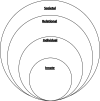Assessing professional identity formation (PIF) amongst medical students in Oncology and Palliative Medicine postings: a SEBA guided scoping review
- PMID: 36397067
- PMCID: PMC9673314
- DOI: 10.1186/s12904-022-01090-4
Assessing professional identity formation (PIF) amongst medical students in Oncology and Palliative Medicine postings: a SEBA guided scoping review
Erratum in
-
Correction: Assessing professional identity formation (PIF) amongst medical students in Oncology and Palliative Medicine postings: a SEBA guided scoping review.BMC Palliat Care. 2023 Jan 26;22(1):7. doi: 10.1186/s12904-022-01120-1. BMC Palliat Care. 2023. PMID: 36698165 Free PMC article. No abstract available.
Abstract
Background: Introduction to a multi-professional team who are working and caring for the dying, and facing complex moral and ethical dilemmas during Oncology and Palliative Medicine postings influence a medical student's professional identity formation (PIF). However, limited appreciation of PIF, inadequate assessments and insufficient support jeopardise this opportunity to shape how medical students think, feel and act as future physicians. To address this gap, a systematic scoping review (SSR) of PIF assessment methods is proposed.
Methods: A Systematic Evidence-based Approach (SEBA) guided SSR of assessments of PIF in medical schools published between 1st January 2000 and 31st December 2021 in PubMed, Embase, ERIC and Scopus databases was carried out. Included articles were concurrently content and thematically analysed using SEBA's Split Approach and the themes and categories identified were combined using SEBA's Jigsaw Perspective. The review hinged on the following questions: "what is known about the assessment of professional identity formation amongst medical students?", "what are the theories and principles guiding the assessment of professional identity formation amongst medical students?", "what factors influence PIF in medical students?", "what are the tools used to assess PIF in medical students?", and "what considerations impact the implementation of PIF assessment tools amongst medical students?".
Results: Two thousand four hundred thirty six abstracts were reviewed, 602 full-text articles were evaluated, and 88 articles were included. The 3 domains identified were 1) theories, 2) assessment, and 3) implementation in assessing PIF. Differing attention to the different aspects of the PIF process impairs evaluations, jeopardise timely and appropriate support of medical students and hinder effective implementation of PIF assessments.
Conclusion: The Krishna-Pisupati model combines current theories and concepts of PIF to provide a more holistic perspective of the PIF process. Under the aegis of this model, Palliative Care and Oncology postings are envisaged as Communities of Practice influencing self-concepts of personhood and identity and shaping how medical students see their roles and responsibilities as future physicians. These insights allow the forwarding of nine recommendations to improve assessments of PIF and shape the design of a PIF-specific tool that can direct timely and personalized support of medical students.
Keywords: Identity; Medical school; Medical students; Mentoring; Oncology; Palliative care; Personhood; Professional identity formation.
© 2022. The Author(s).
Conflict of interest statement
All authors have no conflicting interests.
Figures
Similar articles
-
The impact of online education during the Covid-19 pandemic on the professional identity formation of medical students: A systematic scoping review.PLoS One. 2024 Jan 5;19(1):e0296367. doi: 10.1371/journal.pone.0296367. eCollection 2024. PLoS One. 2024. PMID: 38181035 Free PMC article.
-
A systematic scoping review on group non-written reflections in medical education.BMC Med Educ. 2024 Oct 10;24(1):1119. doi: 10.1186/s12909-024-06117-3. BMC Med Educ. 2024. PMID: 39390436 Free PMC article.
-
A systematic scoping review of mentoring support on professional identity formation.BMC Med Educ. 2024 Nov 27;24(1):1380. doi: 10.1186/s12909-024-06357-3. BMC Med Educ. 2024. PMID: 39605048 Free PMC article.
-
Assessing the effects of a mentoring program on professional identity formation.BMC Med Educ. 2023 Oct 25;23(1):799. doi: 10.1186/s12909-023-04748-6. BMC Med Educ. 2023. PMID: 37880728 Free PMC article.
-
A Scoping Review of Professional Identity Formation in Undergraduate Medical Education.J Gen Intern Med. 2021 Nov;36(11):3511-3521. doi: 10.1007/s11606-021-07024-9. J Gen Intern Med. 2021. PMID: 34406582 Free PMC article.
Cited by
-
Understanding mentoring relationships between mentees, peer and senior mentors.BMC Med Educ. 2023 Jan 31;23(1):76. doi: 10.1186/s12909-023-04021-w. BMC Med Educ. 2023. PMID: 36717909 Free PMC article.
-
Professional identity formation amongst peer-mentors in a research-based mentoring programme.BMC Med Educ. 2023 Oct 24;23(1):787. doi: 10.1186/s12909-023-04718-y. BMC Med Educ. 2023. PMID: 37875886 Free PMC article. Review.
-
A systematic scoping review of mentor training in medical education between 2000 and 2024.BMC Med Educ. 2025 Jul 24;25(1):1110. doi: 10.1186/s12909-025-07353-x. BMC Med Educ. 2025. PMID: 40707917 Free PMC article.
-
Journeying with the Dying-Lessons from Palliative Care Physicians.Asian Bioeth Rev. 2024 Dec 14;17(3):591-613. doi: 10.1007/s41649-024-00321-5. eCollection 2025 Jul. Asian Bioeth Rev. 2024. PMID: 40741311 Free PMC article.
-
Learning to teach with patients and caregivers: a focused ethnography.BMC Med Educ. 2024 Mar 3;24(1):224. doi: 10.1186/s12909-024-05197-5. BMC Med Educ. 2024. PMID: 38433220 Free PMC article.
References
-
- Mason SR, Ellershaw JE. Preparing for palliative medicine; evaluation of an education programme for fourth year medical undergraduates. Palliat Med. 2008;22(6):687–692. - PubMed
-
- Dickinson GE. A quarter century of end-of-life issues in U.S. medical schools. Death Studies. 2002;26(8):635–46. - PubMed
-
- Cherny NI, Fallon MT, Kaasa S, Portenoy RK, Currow DC. Oxford Textbook of Palliative Medicine Oxford: Oxford University Press; 2015. 6 2015.
-
- Wong MK, Hong DZH, Wu J, Ting JJQ, Goh JL, Ong ZY, et al. A systematic scoping review of undergraduate medical ethics education programs from 1990 to 2020. Med Teach. 2022;44(2):167–186. - PubMed
Publication types
MeSH terms
LinkOut - more resources
Full Text Sources
Miscellaneous






